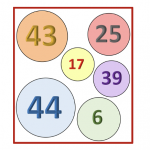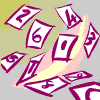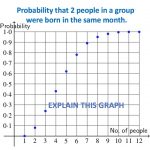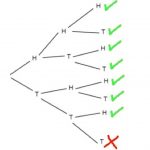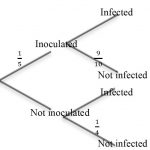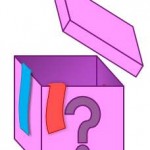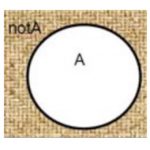In the Lucky Numbers Game 6 balls are numbered 1 to 6 and 3 balls are chosen at random, without replacing any of the balls, so that 3 different winning numbers are chosen. There is no significance in the order of the numbers.
When you play this game you get a ticket with […]
In the Mathopia Lottery, 49 balls numbered 1 to 49 are mixed up and 6 different winning numbers are chosen by choosing 6 balls at random without replacing any of the balls. You can do this with numbered cards instead of balls. To play the game, all the players make their own […]
See the Inclusion and Home Learning Guide for related activities on the same topic for ages 4 to 18+.
How many factors does 72 have?
Investigate numbers that are products of a square number and a cube number. How many factors do they have?
How does the number 1 behave in the world […]
In a group of 23 people there is more than a 50% chance that two will have the same birthday? Does that surprise you?
Including February 29th how many different birthdays can there be? Start with any 3 people A, B and C. What is the probability that B has a different birthday from […]
The probability that there are two people in a group with birthdays in the same month depends on the size of the group.
What if the group has more than twelve people?
What about a group of 2 people? What is the probability they have birthdays in different months?
If Busi has 3 children what is the probability that at least one will be a girl?
Imagine tossing a coin three times.
What’s the probability you will get a head on at least one of the tosses?
Suppose you drew this tree diagram. How would it help you to find the answers to […]
Twenty per cent of the inhabitants of a city have been inoculated against a certain disease. An epidemic hits the city and the chance of infection amongst those inoculated is 10% but amongst the rest it is 75%.
Copy and fill in the contingency table and the Venn diagram below and use them to answer […]
Najwa and Zuki play a game.
They put two red and four blue ribbons in a box. They pull out two ribbons at the same time without looking at the colours.
Najwa wins if both ribbons are the same colour.
Zuki wins if the two ribbons are different colours.
You could play the […]
Mathematical modelling and making real life connections is the focus of this guide. The use of tree diagrams in probability is developed starting with collecting data to model the numbers of boys and girls in families and the orders in which they occur. The connections between the underlying mathematics in these situatons, […]
Practical people maths activities forming human Venn diagrams and contingency tables. Applications to real world problems.
Click here to download a pdf with all you need to run your own professional development workshop.
South Africa COVID-19 News
Here is the official website for COVID-19 updates.
Login
SUPPORT AIMSSEC


